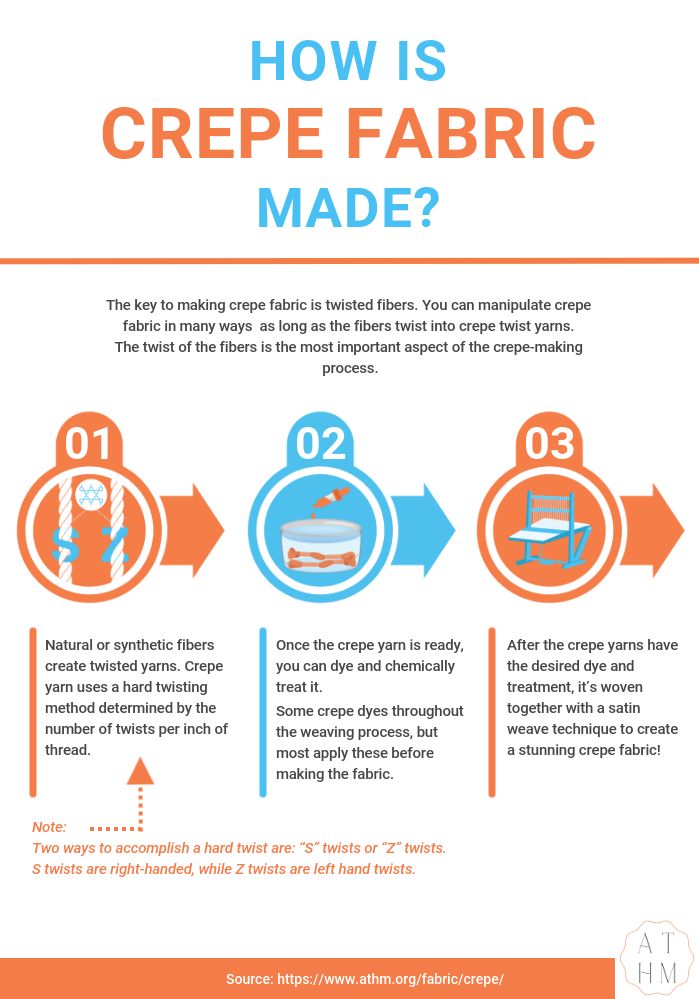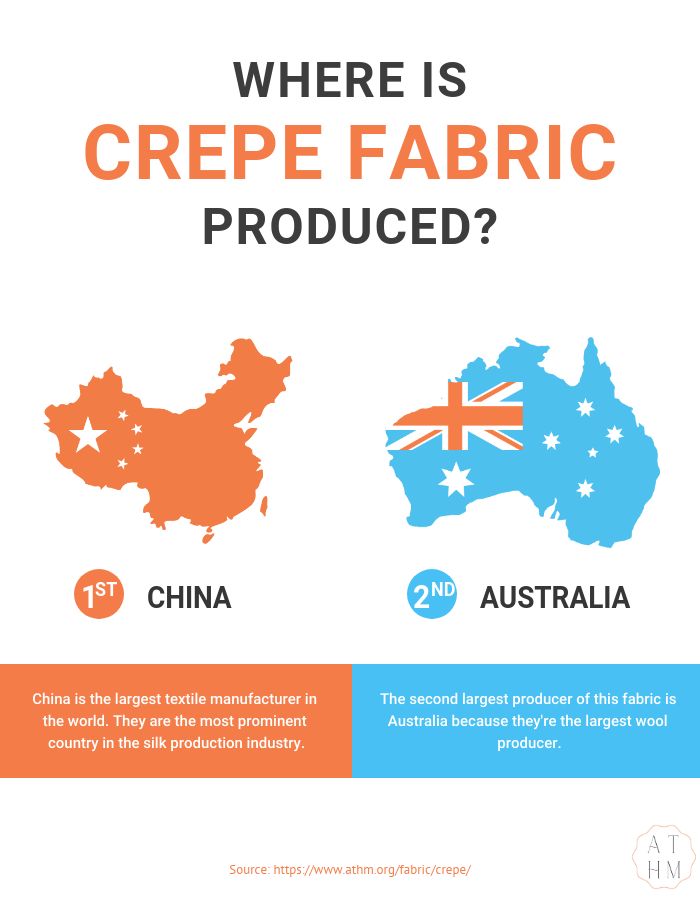Crepe fabric is material that has undergone a special weaving treatment. The result is a rippled and unique three-dimensional texture. It offers impeccable draping capabilities, along with a silky soft texture, making it one of the most desired fabrics in the fashion industry.
While crepe can be tricky to work with, it’s still a beloved fabric because it can create elegant and dramatic clothing with visual textures. Today, most crepe fabric comes from China or Australia, supplying the fashion industry with several types of crepe.
Consider this your comprehensive guide to crepe fabric. This article will discuss crepe fabric’s history, properties, uses, manufacturing process, and anything else you want to know about this luxurious textile.
What Is Crêpe Fabric?
Creping is a fabric treatment or form of weaving that leaves material with a rippled and crinkled appearance. Most crepe fabrics are breathable and soft, making them wearable for all seasons.
While crepe is generally a slippery and luxurious fabric, the texture and flexibility depend heavily on the fabric’s composition, which can vary wildly.
Crepe fabric can use a variety of fibers, including silk, wool, and sometimes synthetic fibers. Some crepes, like those from silk, are high-quality. Unfortunately others, often synthetic, lack the luscious, silky feel that comes with the pricier materials.
Crepe fabric has a subtle crinkled or wrinkled texture and appearance, making it a unique fabric choice. It offers a gorgeous draping and 3D texture, often used to structure gowns or make eveningwear.
To create crepe fabric, you must use an intricate weaving treatment to achieve the 3D, wrinkled texture. For crepe, the fibers must be twisted extremely tight, which results in unique crinkling.
While crepe is a fragile fabric that slips and slides while you try to sew it, the breezy, flowing characteristics and ease of draping make it a favorite fabric among designers and sewers.
History of Crêpe Fabric

Many ancient cultures were able to make crepe fabric, however crepe fabric has no clear single origin because it was so widespread in ancient times.
Silk crepe fabric was first popularized in China, as they had the largest supply of silk in the world. Silk fabrics are the highest quality type of crepe, offering the most luxurious texture and draping abilities. Silk fibers come from the silkworm insect, but other cultures created rougher crepe fabric using cotton fibers from plants or wool fibers from animals.
For centuries, crepe fabric was popular for all-season clothing and fancy attire. Many royals used it as their fabric of choice to make their gowns and other clothing, giving it a high-class status. Despite its popularity among the wealthy and powerful, lower-class people could still make and acquire it using cheaper materials than silk.
One of its most well-known uses is for women’s mourning wear. This tradition became common in many western cultures, especially for mourning mothers or widows. This tradition began around the 19th century but has gone out of fashion in modern times. However, many Greek Orthodox women still wear black crepe to funerals or when they are in mourning.
The fabric is also common in ceremonial garments in certain Indian cultures. The crepe fabric can make saris and other traditional garments for Indian rituals and occasions.
Today, crepe is most popular for garment construction to add texture and volume. It’s also a popular choice for evening wear and gowns. While you likely own clothing with a crepe fabric in it, it’s mostly used in high fashion nowadays.
Properties and Characteristics of Crêpe Fabric
This section will break down the notable characteristics of this material. The fabric characteristics determine its uses and what it’s suitable for. If you consider using crepe fabric for your next project, keep the following characteristics in mind:
Breathable
Crepe is one of the most breathable fabrics, especially if made from twisted silk fibers. Crepe fabric made from synthetics, wool, or cotton is typically less breathable but is still comfortable. The synthetic fabric will have the worst ventilation, while organic materials will be the most breathable. The more breathable the fabric, the better it is for hot-weather clothing. But crepe can work for all seasons, depending on the fibers.
Delicate
Crepe is a very delicate fabric. It’s thin, sheer, and can snag easily on objects. Despite its popularity among high-fashion designers, it can be a pain to work with.
The delicate nature of this fabric is a double-edged sword because it makes for stunning draping and texture, but makes it a very challenging material to make garments with. It’s thin and lightweight, making it ideal for layering and flowy garments.
Flammable
Crepe is a very flammable material, so it’s not ideal for pajamas, bedding, and other household textiles. Because it’s thin and typically produced with organic materials, it has very low heat resistance, so be careful with it!
Silk crepe is the most flammable, but synthetics can also catch fire. Due to the low heat resistance, it also has low heat retention. Even though it’s found in winter clothing, it doesn’t do an excellent job keeping the wearer warm.
Three-Dimensional
Thanks to its unique weaving, crepe fabric has a three dimensional texture. The 3D texture is one of the most alluring characteristics of the fabric. It has a rippled texture that is still elegant. Sometimes silk and satin fabrics can hang too tightly, offering little volume to an outfit.
But crepe has a silky, slippery texture while also bringing some volume and texture to the garment. This texture differentiates it from similar fabrics, allowing crepe to enhance garments in a way the others cannot.
Draping
Crepe is one of the best fabrics for elegant and bold draping. The combination of silky texture, lightweight breathability, and 3D texture makes it easy to drape and create a dazzling effect.
Designers love to experiment with crepe draping, and you’ll commonly see draped crepe on the red carpet!
Adaptable
Despite its fragility, crepe is a highly adaptable fabric. Its versatility makes it suitable for many occasions, from casual to upscale.
You can find crepe in super affordable stores as a blouse or flowy pants, but it’s also common on the runway.
Types of Crêpe Fabric
There are dozens of varieties of crepe using different fibers, weaving styles, and designs. Below is an overview of 17 of the most well-known types of crepe:
Aerophane
Aerophane crepe became popular during the 1800s, and it has a distinct gauze-like texture. It’s often more crinkled and sheer than other crepe varieties. This type of crepe is not in production anymore, but more modern crepe varieties have a similar texture.
Baute Satin
Baute satin is one of the most intricate types of crepe. It uses a complex warp weaving pattern with a reversed plain crepe design. Baute satin falls under the category of French crepe, and it is a popular fabric today.
Canton
One of the most well-known crepe fabrics is the Canton crepe, produced exclusively in China. It’s mostly used in high-end Asian-inspired garments.
Crepe Anglaise
Crepe Anglaise is always a black and white fabric popularized in England. It’s even been used as a peace offering and artifact during times of war. It has the classic slippery feeling, and its distinction is the black and white dye job.
Crepe De Sante
Crepe de Sante, also called rough crepe, is similar to aerophane in its gauze-like texture. However, Crepe de Sante has a rougher texture, typically made using synthetic or wool fibers.
Crepeline
Crepeline is another variety that came about in the 1800s. It’s ideal for dramatic garment instruction because it has more volume and stiffness than other crepe fabrics.
Crepon
Crepon is a heavier crepe fabric, often used to make cold-weather clothing and undergarments. It typically uses wool or heavy synthetics like polyester.
French Crepe
French crepe is often the most used variety of crepe because it’s high-quality and appealing. It’s common in lingerie or fancy evening wear. People also refer to it as “flat crepe”, due to its impeccable draping and delicate texture.
Plisse
Possibly the most well-known variety is plisse crepe. It has a distinctive puckered texture, adding to the wrinkly effect of this fabric. Plisse crepe fibers undergo a chemical treatment that makes them more voluptuous and textured. It is popular in evening wear and gowns.
Crepe De Chine
Crepe de Chine is super lightweight and luxurious. It’s made from silk but lacks the clear-cut finish of most textured crepes. Crepe de Chine has a pebbly surface and matte texture with a super smooth texture. Crepe de Chine is less slippery than other satin crepes, but still ideal for evening wear.
Crepe Georgette
Crepe Georgette is a cross between classic crepe fabric and Georgette fabric. It’s a stretch crepe, allowing it to drape well, but it’s easier for sewers and designers. Sometimes crepe Georgette and chiffon fabric are used interchangeably.
Moroccan Crepe
Moroccan crepe has a heavy texture compared to other crepe fabrics. It uses rayon, wool, or silk fibers, resulting in a ribbed crepe fabric with a wavy texture.
Wool Crepe
Wool crepe uses wool fibers, unsurprisingly. It’s a more wiry fabric that looks luxurious. The production process involves treating the threads with chemicals during the weaving.
Synthetic Crepe
Polyester crepe is the most common synthetic option, but this synthetic crepe fabric can also use polyester or elastane. It’s relatively thin and lightweight, even for a crepe fabric. It offers a stunning flowy drape and is best for blouses, skirts, and dresses. Sometimes elastane or similar synthetic fibers mix with the polyester fibers to make a stretchier crepe fabric.
Crepe-Back Satin
While most crepe fabrics feel the same on either side, crepe-back satin combines satin and crepe textures. One side has a smooth, slippery texture while the other has a wrinkly appearance and rougher feeling or crepe.
Crepe Charmeuse
This type of crepe fabric uses silk fibers woven using the satin weave. It’s one of the highest quality crepes, offering a flat back and flowing appearance.
Scuba Crepe
This crepe fabric uses polyester fibers and a small percentage of spandex. It looks and feels like crepe, but it behaves with more elasticity, making it easier to work with and use for more casual clothing.
How Is Crêpe Fabric Made?

The key to making crepe fabric is twisted fibers. While most crepe fabrics use the satin weave to accomplish the breezy feel, people experiment with the plain weave and twill weave too!
These variations are still categorized as crepe fabric, as long as the fibers twist into crepe twist yarns. Essentially, the tightly twisted fibers are what defines the fabric.
As you can see from the above section, you can manipulate crepe fabric in many ways to create variations of this popular fabric. But the general process to make a crepe fabric is as follows:
- Natural or synthetic fibers create twisted yarns. Crepe yarn uses a hard twisting method determined by the number of twists per inch of thread.
Note: Two ways to accomplish a hard twist are: “S” twists or “Z” twists. S twists are right-handed, while Z twists are left hand twists. To the untrained eye, the twists can look very similar.
- Once the crepe yarn is ready, you can dye and chemically treat it. Some crepe varieties use dyes or treatment chemicals throughout the weaving process, but most apply these before making the fabric.
- After the crepe yarns have the desired dye and treatment, it’s woven together with a satin weave technique to create a stunning crepe fabric!
As mentioned, the twist of the fibers is the most important aspect of the crepe-making process. Without crepe yarns, the fabric cannot be considered a crepe fabric.
How Is Crêpe Fabric Used?
Crepe has hundreds of uses, mostly in the fashion industry. However, some home decor and goods can use crepe to create a stunning atmosphere.
Despite how tricky crepe fabric can be to work with, it’s still one of the most popular fabrics, thanks to its dramatic appearance and stunning texture.
High Fashion
Crepe finds its way into high fashion all the time. Crepe is an excellent material for creating gorgeous draping and dramatic clothing. Along with fashion, crepe is common in costumes and other decorative garments, like clothes for ceremonial occasions.
- Evening gowns
- Wedding dresses
- Mourning wear
- Blouses
- Skirts
- Pants
- Lingerie
- Ceremonial dresses
Casual Wear
While crepe has a home in high fashion, it’s also in casual, everyday clothing! While it has a similar feel to luxurious fabrics like satin and silk, it is more durable. As discussed, crepe is delicate but still tougher than fabrics like sateen or chiffon. Below are examples of casual wear:
- Shirts
- Pants
- Skirts
- Dresses
Accessories
Because crepe is so airy and luxurious, it’s easy to use it in decorative accessories. It offers a show-stopping appearance without being obnoxious or overwhelming. You can find accessories using crepe-like:
- Scarves
- Hats
- Gloves
- Shawls
- Wraps
Household Textiles
While crepe is most popular for clothing, it can also work as a household textile. If you love crepe and want to incorporate it into your home, it can work as the following items:
- Curtains
- Home decor
- Pillowcases
- Bed sheets
- Tablecloths
- Napkins
Advantages of Crêpe Fabric
Crepe has many top-notch qualities, making it a popular choice for various garments and products. Below are the top advantages to consider:
Fluid Draping
For dramatic draping, crepe is one of the best fabrics. It can be manipulated easily and has a flowy, breezy element ideal for draping.
Visual Texture
Crepe has a distinct wrinkly effect that brings a textured and 3D element to any garment. Due to its sheerness and draping abilities, it’s ideal for creating textured garments with an elegant flair.
Comfortable and Soft
Crepe is a soft and comfortable fabric that most people enjoy wearing. Unlike silk and other high-end fabrics, crepe has slightly more stretch and breathability.
Disadvantages of Crêpe Fabric
This section will discuss the disadvantages of using crepe fabric. While it’s a wonderful material, it isn’t always an ideal choice.
Fragile
Crepe is more durable than similar fabrics, like satin, silk, and chiffon, which snag easily. However, crepe is still a highly delicate fabric that can be damaged if not treated with the utmost care.
Slippery
While the slippery, soft texture is comfortable and enjoyable to wear, it can be a pain to try to cut and sew it. Making crepe garments can be a challenge for those unfamiliar with the fabric.
High-Maintenance
Crepe garments must be hand-washed and air-dried, making them a high-maintenance fabric to care for.
Alternatives to Crêpe Fabric
Crepe can be a relatively expensive fabric and tough to work with. If you want an alternative to crepe fabric with a similar texture and draping capabilities, you can replace the crepe with one of the fabrics listed below.
- Chiffon
- Silk
- Satin
- Organza
- Gauze
- Sateen
- Charmeuse
- Tulle
Where Is Crêpe Fabric Produced?

While crepe fabric can come from anywhere, the biggest supplier of this fabric is China.
China is the largest textile manufacturer in the world. They are the most prominent country in the silk production industry.
The second largest producer of this fabric is Australia because they’re the largest wool producer.
How Much Does Crêpe Fabric Cost?
Crepe fabric can cost anywhere between $5 per yard and $100 per yard, depending on the quality. For example, 100% silk crepe can cost $90 per yard, while a polyester crepe fabric can cost as little as $5.
On average, most people pay between $20 and $50 for a quality crepe. This price range makes it an accessible fabric no matter your budget, but you may have to sacrifice some quality.
What Certifications Are Available for Crêpe Fabric?
Four fabric certifications are available for crepe: Responsible Wool Standard, Woolmark Certification, Global Recycled Standard, and Silk Mark Certification.
Responsible Wool Standard
To receive this certification, wool products must adhere to strict guidelines and quality standards. It also concerns how well the animals are treated who supply the wool fibers. Only the best wool manufacturer can receive this certification.
Woolmark Certification
The Woolmark Certification concerns the quality of the wool. Manufacturers must also adhere to rules to receive this certification, indicating they produce some of the best wool fibers in the world.
Global Recycled Standard
The Global Recycled Standard applies to synthetic fibers and materials. Polyester crepe, rayon crepe, or elastane crepe can receive this certification. To receive this certification, the manufacturer must use recycled polyester and synthetic materials to create new garments.
Silk Mark Certification
Silk is one of the most luxurious materials in the world, therefore the quality and integrity of the silk fibers used in crepe fabric play a huge role in the quality of the woven fabric. Silk Mark is an organization that certifies silk products, checking for quality and authenticity.
To receive this Silk Mark certification, the manufacturer must produce sustainably and pay adequate respect to silkworm insects, mulberry trees, and any humans involved in the production.
What Is the Environmental Impact of Manufacturing Crêpe Fabric?
The environmental impact of crepe depends heavily on the type of crepe. Silk, wool, and other organic crepe fabrics are highly sustainable, making little to no negative impact on the environment.
On the other hand, synthetic crepes can introduce harmful chemicals into the environment, such as xenoestrogens and petrochemicals.
Conclusion
Even if you don’t realize it, you probably have some crepe hanging in your closet. It’s a versatile fabric people still consider luxurious and high-fashion.
While most people think of a thin pancake when they hear the word crepe, anyone in the fashion industry will likely think of this luscious and stunning fabric. Despite being one of the oldest fabrics, it still has a firm place in modern fashion.
